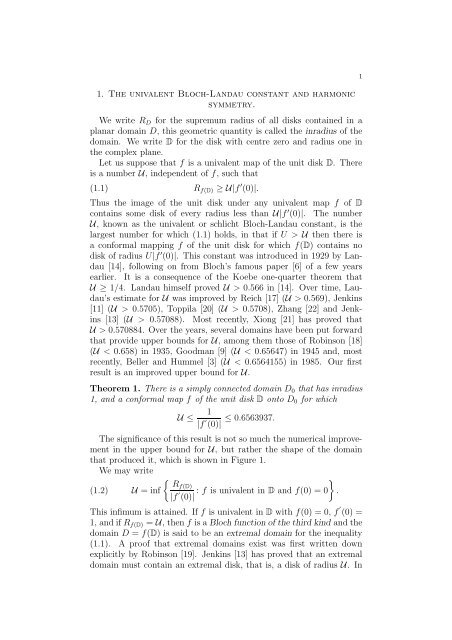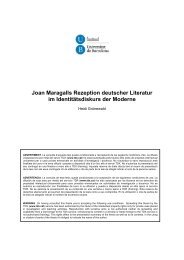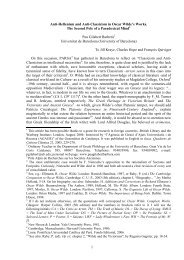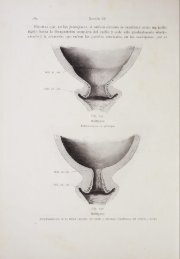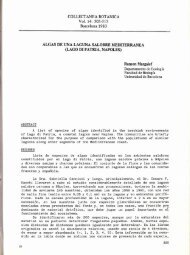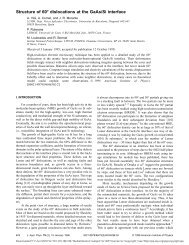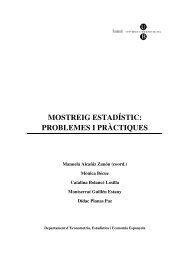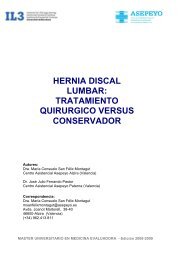The univalent Bloch-Landau constant, harmonic symmetry and ...
The univalent Bloch-Landau constant, harmonic symmetry and ...
The univalent Bloch-Landau constant, harmonic symmetry and ...
You also want an ePaper? Increase the reach of your titles
YUMPU automatically turns print PDFs into web optimized ePapers that Google loves.
1. <strong>The</strong> <strong>univalent</strong> <strong>Bloch</strong>-<strong>L<strong>and</strong>au</strong> <strong>constant</strong> <strong>and</strong> <strong>harmonic</strong><br />
<strong>symmetry</strong>.<br />
We write R D for the supremum radius of all disks contained in a<br />
planar domain D, this geometric quantity is called the inradius of the<br />
domain. We write D for the disk with centre zero <strong>and</strong> radius one in<br />
the complex plane.<br />
Let us suppose that f is a <strong>univalent</strong> map of the unit disk D. <strong>The</strong>re<br />
is a number U, independent of f, such that<br />
(1.1) R f(D) ≥ U|f ′ (0)|.<br />
Thus the image of the unit disk under any <strong>univalent</strong> map f of D<br />
contains some disk of every radius less than U|f ′ (0)|. <strong>The</strong> number<br />
U, known as the <strong>univalent</strong> or schlicht <strong>Bloch</strong>-<strong>L<strong>and</strong>au</strong> <strong>constant</strong>, is the<br />
largest number for which (1.1) holds, in that if U > U then there is<br />
a conformal mapping f of the unit disk for which f(D) contains no<br />
disk of radius U|f ′ (0)|. This <strong>constant</strong> was introduced in 1929 by <strong>L<strong>and</strong>au</strong><br />
[14], following on from <strong>Bloch</strong>’s famous paper [6] of a few years<br />
earlier. It is a consequence of the Koebe one-quarter theorem that<br />
U ≥ 1/4. <strong>L<strong>and</strong>au</strong> himself proved U > 0.566 in [14]. Over time, Laudau’s<br />
estimate for U was improved by Reich [17] (U > 0.569), Jenkins<br />
[11] (U > 0.5705), Toppila [20] (U > 0.5708), Zhang [22] <strong>and</strong> Jenkins<br />
[13] (U > 0.57088). Most recently, Xiong [21] has proved that<br />
U > 0.570884. Over the years, several domains have been put forward<br />
that provide upper bounds for U, among them those of Robinson [18]<br />
(U < 0.658) in 1935, Goodman [9] (U < 0.65647) in 1945 <strong>and</strong>, most<br />
recently, Beller <strong>and</strong> Hummel [3] (U < 0.6564155) in 1985. Our first<br />
result is an improved upper bound for U.<br />
<strong>The</strong>orem 1. <strong>The</strong>re is a simply connected domain D 0 that has inradius<br />
1, <strong>and</strong> a conformal map f of the unit disk D onto D 0 for which<br />
U ≤ 1<br />
|f ′ (0)| ≤ 0.6563937.<br />
<strong>The</strong> significance of this result is not so much the numerical improvement<br />
in the upper bound for U, but rather the shape of the domain<br />
that produced it, which is shown in Figure 1.<br />
We may write<br />
{ }<br />
Rf(D)<br />
(1.2) U = inf<br />
|f ′ (0)| : f is <strong>univalent</strong> in D <strong>and</strong> f(0) = 0 .<br />
This infimum is attained. If f is <strong>univalent</strong> in D with f(0) = 0, f ′ (0) =<br />
1, <strong>and</strong>if R f(D) = U, then f is a <strong>Bloch</strong> functionof the third kind <strong>and</strong>the<br />
domain D = f(D) is said to be an extremal domain for the inequality<br />
(1.1). A proof that extremal domains exist was first written down<br />
explicitly by Robinson [19]. Jenkins [13] has proved that an extremal<br />
domain must contain an extremal disk, that is, a disk of radius U. In<br />
1


